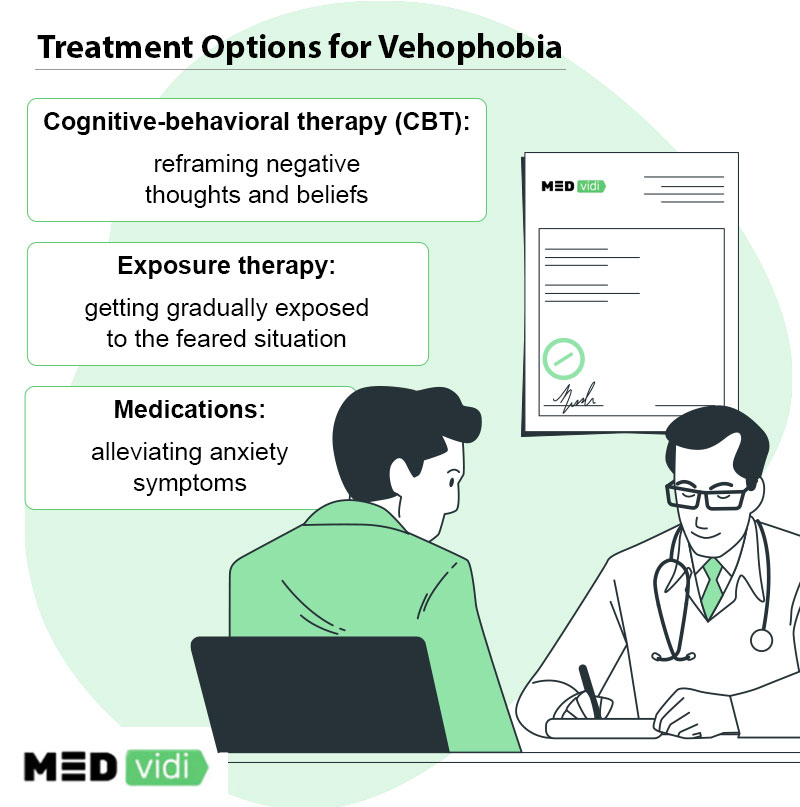Do you ever get a knot in your stomach or feel your palms start sweating when you think about getting behind the wheel of a car? If so, you could be suffering from vehophobia, a fear of driving. But do not worry; you are not alone.
About
What is Vehophobia?
Amaxophobia, hamaxophobia, ochophobia, and motorphobia are all terms for the same condition: a phobia of driving. This fear is chronic and intense, causing distress when someone attempts to operate or ride in a vehicle.
People with vehophobia may feel overwhelming anxiety when they are in a car or even thinking about traveling in a vehicle. This fear can be disabling, as it can lead to
Causes of Vehophobia
Though the exact cause of vehophobia is not known,
- Past trauma. People who have experienced a traumatic event while driving or riding in a car can develop vehophobia. This trauma can range from a serious car accident to a minor fender bender.
- Heredity. Having cases of anxiety disorders or phobic disorders in the family (a parent or another close relative suffered from them) makes one more likely to have a phobia. Also, a specific gene mutation can contribute to an increased risk.
- Modeling. Being close to someone having this phobia, seeing their reactions, and listening to their experiences can cause the development of this phobia.
- Fear of the unknown. Driving involves being in an unfamiliar environment. Being surrounded by other drivers, who may or may not be skilled and aware of the rules of the road, and these factors can create anxiety.
- Fear of losing control. For some people, the thought of being unable to control the situation or the outcome if something were to go wrong can be frightening and lead to vehophobia.
- Fear of injury. The thought of being injured in a car accident is a major source of anxiety and can lead to vehophobia. The idea of being trapped in a vehicle with no escape can be overwhelming and frightening.
- Fear of speed. The inability to control the speed of the vehicle and the potential for an accident to occur can lead to vehophobia. Sometimes, just the thought of driving at a high speed can be a source of anxiety and fear.
Symptoms of Driving Phobia
Any vehicle, such as cars, buses, trains, planes, or boats, can trigger amaxophobia. It can happen when driving a vehicle or imagining yourself inside it. In some cases, just seeing a vehicle (in real life or on TV) can trigger the symptoms of anxiety and phobia too.
The physical symptoms of vehophobia include:
- Trembling
- Feeling tense
- Rapid heartbeat
- Difficulty breathing
- Sweaty palms
- Nausea
- Upset stomach
- Dizziness
- Difficulty concentrating
The psychological symptoms of vehophobia can be:
- A feeling of panic and fear
- Panic attacks
- Intrusive thoughts, such as fears of crashing or getting into an accident
- Avoidance of driving or riding
- Withdrawal from social situations
- Feelings of shame and embarrassment
Treatment Options
Psychotherapy
Vehophobia can be an overwhelming and terrifying experience. However, it is possible to cope with and treat it with the assistance of specialists.
- Exposure therapy. It involves gradually exposing the person to the sight and sounds of vehicles, as well as driving and riding in them. The exposure to different aspects of the feared situation starts with the least threatening and progresses to more intense levels. This process can help a person become less sensitive to a stimulus in a safe and controlled environment, such as a parking lot. The goal is to help them control their fear and become comfortable with these situations. In recent studies, a dynamic approach called Virtual Reality Exposure Therapy (
VRET[4] ) has emerged as a promising method to help people with fear of driving reduce their anxiety. - Cognitive-behavioral therapy (CBT).
CBT[5] can help vehophobes to successfully manage their fear and anxiety and ultimately gain control of their lives. It can involve a combination of cognitive restructuring, relaxation techniques, and gradual exposure to driving-related activities. This therapy helps to challenge and reframe unhelpful thoughts and beliefs about driving, allowing sufferers to gradually increase their comfort and confidence behind the wheel.

Medication
Medication is not typically the primary approach to treating vehophobia. Nonetheless, certain medications may be used to help alleviate symptoms of anxiety related to specific phobias.
- Selective serotonin reuptake inhibitors (SSRIs). They increase the amount of serotonin in the brain, which can help reduce anxiety and improve your mood. They can also help you better manage your fear in response to certain triggers. Common SSRIs are Prozac, Paxil, and Zoloft.
- Tricyclic antidepressants. They boost the amount of serotonin and norepinephrine in the brain, which can help to reduce anxiety and improve mood. Examples of tricyclic antidepressant drugs are Elavil and Pamelor.
- Monoamine oxidase inhibitors (MAOIs). By blocking the enzyme, MAOIs increase the number of neurotransmitters available in the brain, resulting in feelings of calm and improved mood. Marplan and Nardil are common MAOIs.
- Beta-blockers. Beta-blockers block the effects of adrenaline in the body, allowing the heart rate and blood pressure to remain steady and helping individuals feel calm. Inderal is the most widely used beta-blocker for this purpose.
- Benzodiazepines. They work by increasing the activity of GABA, a neurotransmitter that helps to calm the nervous system. They are used to manage panic attacks caused by phobias. Xanax, Ativan and Klonopin are the main medications in this class.
Final Thoughts
While fear of driving is nothing to be ashamed of, it can greatly interfere with a person’s quality of life. Nowadays, there are a variety of ways to help those suffering from vehophobia manage and overcome their fear of driving.
If you are looking for specialized support for your anxiety or phobias, the online mental health clinic MEDvidi has you covered. Qualified psychotherapists from your state are ready to create a personalized treatment plan right for you. You can have therapy sessions via video calls and get medicine prescriptions online.








